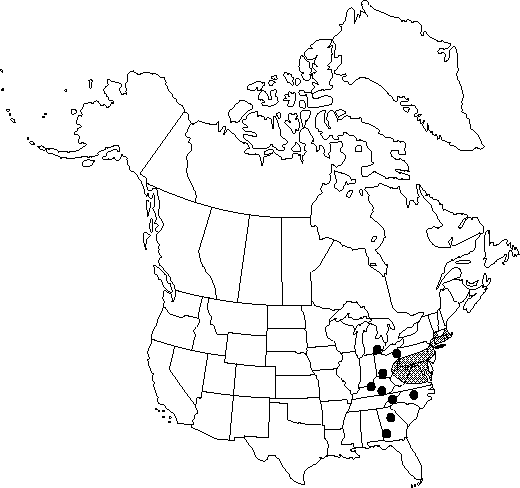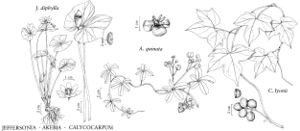Difference between revisions of "Akebia quinata"
Arch. Mus. Hist. Nat. 1: 195, fig. 1(a-c). 1839.
FNA>Volume Importer |
FNA>Volume Importer |
||
| Line 27: | Line 27: | ||
}}<!-- | }}<!-- | ||
| − | --><span class="statement" id="st- | + | --><span class="statement" id="st-undefined" data-properties=""><b>Plants,</b> deciduous to semi-evergreen, climbing to 12 m, glabrous. <b>Leaves</b>: petiole 1.6-12.5 cm; leaflets mostly 5, petiolules 0.2-2.2 cm, blades oblong to ovate-elliptic, 0.7-8.2 × 0.4-4.2 cm, base rounded, margins entire, apex retuse. <b>Inflorescences</b> pendent, 4.5-12 cm; pedicel with basal bracts. <b>Flowers</b> fragrant. <b>Staminate</b> flowers 4-15 per inflorescence, 1.2-1.6 cm diam.; sepals oblong to ovate or elliptic, 5-9 mm; stamens 4-5 mm. <b>Pistillate</b> flowers (0-)1-5 per inflorescence, 2-3 cm diam.; sepals elliptic to ovate or nearly orbiculate, 10 16mm; pistils 3-7, 1 or more maturing. <b>Follicles</b> glaucous, violet to dark purple, oblong, 5-15 cm. <b>Seeds</b> black, ovoid, embedded in whitish pulp.</span><!-- |
-->{{Treatment/Body | -->{{Treatment/Body | ||
| Line 33: | Line 33: | ||
|habitat=Waste places, open woodlands | |habitat=Waste places, open woodlands | ||
|elevation=0-400 m | |elevation=0-400 m | ||
| − | |distribution=Conn.;Ga.;Ind.;Ky.;Md.;Mass.;Mich.;N.J.;N.Y.;N.C.;Ohio;Pa.;Va.;W.Va.;native;Asia | + | |distribution=Conn.;Ga.;Ind.;Ky.;Md.;Mass.;Mich.;N.J.;N.Y.;N.C.;Ohio;Pa.;Va.;W.Va.;native;Asia. |
|discussion=<p>No specimens are known from Rhode Island.</p><!-- | |discussion=<p>No specimens are known from Rhode Island.</p><!-- | ||
--><p>A fast-growing, invasive vine whose aggressiveness may at times approach that of Lonicera japonica, Akebia quinata is occasionally planted as an ornamental; it is of more botanical than horticultural interest. A greenish to whitish flowered variant, known from Asia, is cultivated in North America. The edible, though allegedly insipid, fruits are apparently uncommon in cultivation; cross pollination appears to be necessary for their development (C. S. Sargent 1891).</p> | --><p>A fast-growing, invasive vine whose aggressiveness may at times approach that of Lonicera japonica, Akebia quinata is occasionally planted as an ornamental; it is of more botanical than horticultural interest. A greenish to whitish flowered variant, known from Asia, is cultivated in North America. The edible, though allegedly insipid, fruits are apparently uncommon in cultivation; cross pollination appears to be necessary for their development (C. S. Sargent 1891).</p> | ||
| Line 54: | Line 54: | ||
|habitat=Waste places, open woodlands | |habitat=Waste places, open woodlands | ||
|elevation=0-400 m | |elevation=0-400 m | ||
| − | |distribution=Conn.;Ga.;Ind.;Ky.;Md.;Mass.;Mich.;N.J.;N.Y.;N.C.;Ohio;Pa.;Va.;W.Va.;native;Asia | + | |distribution=Conn.;Ga.;Ind.;Ky.;Md.;Mass.;Mich.;N.J.;N.Y.;N.C.;Ohio;Pa.;Va.;W.Va.;native;Asia. |
|introduced=true | |introduced=true | ||
|reference=None | |reference=None | ||
| Line 60: | Line 60: | ||
|publication year=1839 | |publication year=1839 | ||
|special status=Selected by author to be illustrated;Introduced | |special status=Selected by author to be illustrated;Introduced | ||
| − | |source xml=https://jpend@bitbucket.org/aafc-mbb/fna- | + | |source xml=https://jpend@bitbucket.org/aafc-mbb/fna-data-curation.git/src/9216fc802291cd3df363fd52122300479582ede7/coarse_grained_fna_xml/V3/V3_218.xml |
|genus=Akebia | |genus=Akebia | ||
|species=Akebia quinata | |species=Akebia quinata | ||
| − | |||
| − | |||
| − | |||
| − | |||
| − | |||
| − | |||
| − | |||
| − | |||
| − | |||
| − | |||
| − | |||
| − | |||
| − | |||
| − | |||
| − | |||
| − | |||
| − | |||
| − | |||
| − | |||
| − | |||
| − | |||
| − | |||
| − | |||
| − | |||
| − | |||
| − | |||
| − | |||
| − | |||
| − | |||
| − | |||
| − | |||
| − | |||
}}<!-- | }}<!-- | ||
-->[[Category:Treatment]][[Category:Akebia]] | -->[[Category:Treatment]][[Category:Akebia]] | ||
Revision as of 14:35, 27 July 2019
Plants, deciduous to semi-evergreen, climbing to 12 m, glabrous. Leaves: petiole 1.6-12.5 cm; leaflets mostly 5, petiolules 0.2-2.2 cm, blades oblong to ovate-elliptic, 0.7-8.2 × 0.4-4.2 cm, base rounded, margins entire, apex retuse. Inflorescences pendent, 4.5-12 cm; pedicel with basal bracts. Flowers fragrant. Staminate flowers 4-15 per inflorescence, 1.2-1.6 cm diam.; sepals oblong to ovate or elliptic, 5-9 mm; stamens 4-5 mm. Pistillate flowers (0-)1-5 per inflorescence, 2-3 cm diam.; sepals elliptic to ovate or nearly orbiculate, 10 16mm; pistils 3-7, 1 or more maturing. Follicles glaucous, violet to dark purple, oblong, 5-15 cm. Seeds black, ovoid, embedded in whitish pulp.
Phenology: Flowering spring, fruiting fall (Sep–Oct).
Habitat: Waste places, open woodlands
Elevation: 0-400 m
Distribution

Conn., Ga., Ind., Ky., Md., Mass., Mich., N.J., N.Y., N.C., Ohio, Pa., Va., W.Va., native, Asia.
Discussion
No specimens are known from Rhode Island.
A fast-growing, invasive vine whose aggressiveness may at times approach that of Lonicera japonica, Akebia quinata is occasionally planted as an ornamental; it is of more botanical than horticultural interest. A greenish to whitish flowered variant, known from Asia, is cultivated in North America. The edible, though allegedly insipid, fruits are apparently uncommon in cultivation; cross pollination appears to be necessary for their development (C. S. Sargent 1891).
Selected References
None.
